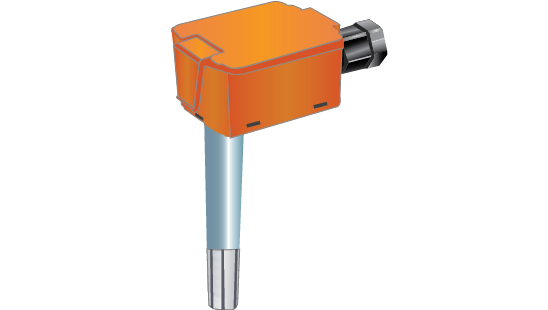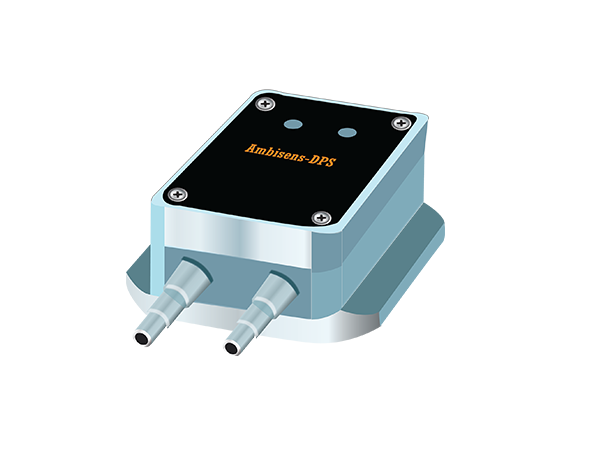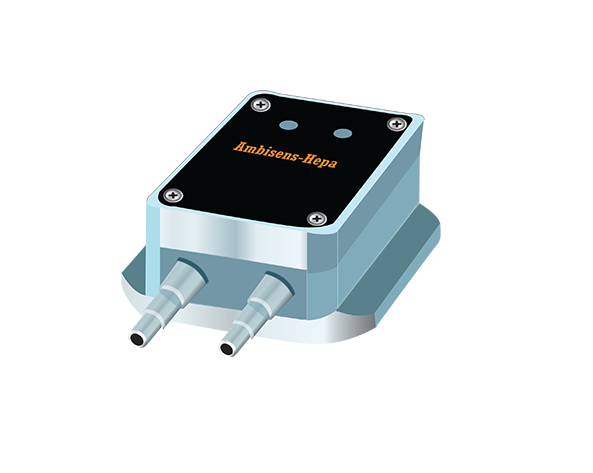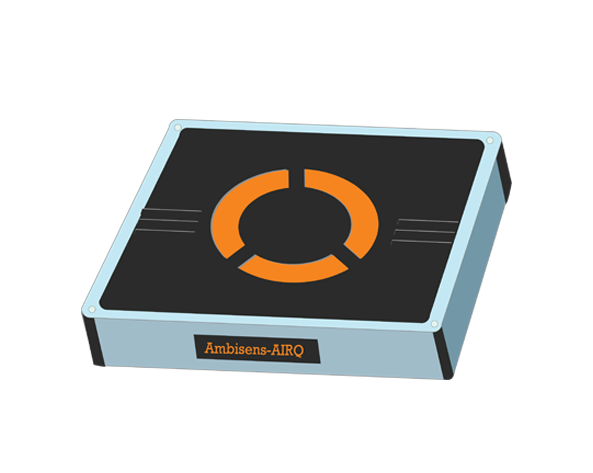These compact, accurate and highly reliable sensors provide continuous transmission of Temperature and Humidity from a single combine probe. The output can be configured to 4-20ma or 0-10VDC or wireless mode. Interfacing these sensors with our panels is super simple and quick.
Ambisense-DPS Differential Pressure monitoring helps prevent spread of infectious diseases and maintain sterile work environments by actively measuring pressurized airflow between a positive or negative buffer room and the ante-room.
It provides continuous reading of the difference in pressure in the operating room compared to the outside and triggers an alarm if the positive pressure dips below a preset value. It is specially designed to support high accuracy of +-3 pa / 0.01 that is important for Operating room pressure.
These sensors are specially designed and calibrated to detect the airflow through the hepa filters. This provides continuous monitoring of efficiency of Hepa filters and raises an alarm when the airflow across the Hepa filter drops below the optimal levels. This enables timely replacement of filters and ensures high quality of air in clean rooms and Operating theaters.
Abmisens-AirQ sensors monitor the quality of air by detecting the suspended particles in air. It is key to ensuring a safe environment in cleanrooms and Operation theaters. Continuous particle counting helps with early detection of leaks or cracks that cause spike in suspended particles. A timely detection prevents OR integrity and patient health from being severely compromised.
Ambisense sensors are specially designed probes for continuous reading of room environment parameters including Temperature (C/F), Humidity (RH), Differential Pressure in Room, Pressure Around Hepa Filters and Particulate count affecting Air quality.
Operating rooms (ORs) are among the most thoroughly regulated spaces in a hospital. It’s a place where patients are particularly at risk of contracting an airborne infection. A successful surgery relies on both the skill of medical professionals and the integrity of the space. Controlling this critical environment with the proper monitoring of environmental parameters helps patient safety and protection from contagions.
These sensors deploy technologies like On-Chip-DSP with robust sensing material to give it a long lifespan with consistent readings throughout. Carefully crafted enclosure and probes provide outstanding protection against contamination and condensation ensuring flawless operation. Properly matched and tested with all our Panels for seamless integration with our line of Operating room products.
These sensors can easily be installed in wired or wireless modes and provide continuous monitoring and interface with cloud for remote administration.

AmbiSense THS – Temperature & Humidity
These compact, accurate and highly reliable sensors provide continuous transmission of Temperature and Humidity from a single combine probe. The output can be configured to 4-20ma or 0-10VDC or wireless mode. Interfacing these sensors with our panels is super simple and quick. Applications- HVAC
- Cleanrooms
- Operating rooms
- Patient isolation rooms
- Pharmaceutical labs
- Industrial manufacturing
- Compounding pharmacies

Ambisense DPS – Differential Pressure
Ambisense-DPS Differential Pressure monitoring helps prevent spread of infectious diseases and maintain sterile work environments by actively measuring pressurized airflow between a positive or negative buffer room and the ante-room. It provides continuous reading of the difference in pressure in the operating room compared to the outside and triggers an alarm if the positive pressure dips below a preset value. It is specially designed to support high accuracy of +-3 pa / 0.01 that is important for Operating room pressure. These Sensors can be the key to monitor air flow COVID-19 Isolation rooms by ensuring negative pressure in the patient room. These sensors can easily be installed in wired or wireless modes and provide continuous monitoring and interface with cloud for remote administration. Applications- Operating Rooms
- Airborne Infection Isolation (AII) Rooms
- Protective Environment (PE) Rooms
- HVAC Systems
- Sterile Lab Environments
- Laboratories
- Cytology Labs
- Animal Testing Research Facilities
- Pharmaceutical Clean Rooms
- Positive and negative air flow
- Range: +/- 0.5 inH2O
- Accuracy: +/- 0.01 inH2O
- Audible alarms
- Cloud Connectivity
- Wireless option

Ambisens-Hepa
These sensors are specially designed and calibrated to detect the airflow through the hepa filters. This provides continuous monitoring of efficiency of Hepa filters and raises an alarm when the airflow across the Hepa filter drops below the optimal levels. This enables timely replacement of filters and ensures high quality of air in clean rooms and Operating theaters. Salient Features- Continuous monitoring of pressure
- Analog feedback to control Fan speed to regulate airflow
- Audible alarms
- Cloud Connectivity
- Wireless option

Ambisens AirQ
Abmisens-AirQ sensors monitor the quality of air by detecting the suspended particles in air. It is key to ensuring a safe environment in cleanrooms and Operation theaters. Continuous particle counting helps with early detection of leaks or cracks that cause spike in suspended particles. A timely detection prevents OR integrity and patient health from being severely compromised. Benefits- Precise measurements for different types of dust and other particles
- Laser-based for Accurate high-resolution particle size binning.
- Reliability of more than ten years while operating continuously for 24 hours/day.
- No need for cleaning and/or maintenance, thus avoiding problems related to sensor drift or malfunction.
- Compact and easy to install.

Ambisens-DPS For Laminar Flow
Ambisens sensors are key to enable a safe and effective Laminar Flow Why Laminar Air Flow? Patients undergoing invasive procedures are highly susceptible to surgical infections and are more than 10% of all hospital-acquired infections. Air circulation in an operating room plays a critical role for the safety of the patient and surgery team while providing a comfortable ambience. The primary sources of contaminants in clean environments are from infiltration, contamination by occupants and from ventilation systems. Maintaining a positive air pressure in operating theatres prevents the flow of air from less sterile areas into more sterile ones. The pressure in OR should be kept at a higher pressure than in corridors and adjacent areas. In addition, High efficiency (HEPA) filters used in ventilation systems such as Laminar Air Flow are common and most efficient methods to reduce contaminants in air flow and reduce surgical site infections., They play a pivotal role in minimizing the percentage of particles impacting the surgical site.

Ambisens-AirQ For Air Quality
Why is Air quality important and How can Ambisens-AirQ help ?Particulate Matter is a mixture of airborne solid particles and liquid droplets that can be inhaled and may cause serious health problems. PM includes particles with different characteristics – i.e. shape, optical properties, size and composition ¬– but it is most commonly divided into sub-categories based on the particle size information. Different PM categories are usually reported under the common nomenclature of PMx, where ‘x’ defines the maximum particle diameter in the airborne particle mixture or ‘aerosol’. PM2.5 defines inhalable particles with a diameter of generally 2.5 micrometers and smaller, PM10 particles with a diameter of 10 micrometers and smaller, and so forth. The specific PM categories of PM10 and PM2.5 have been historically identified by national governments as important monitoring levels in order to assess the quality of the air we breathe , , because PM10 particles irritate exposed mucous such as the eyes and throat and PM2.5 particles travel all the way through the lungs. The smaller the particles are, the deeper they can penetrate through our respiratory system and into our bloodstream, posing a higher hazard to our health. The World Health Organization (WHO) reports airborne particulate matter as a Group 1 carcinogen and as the biggest environmental risk to health, with responsibility for about one in every nine deaths annually.




